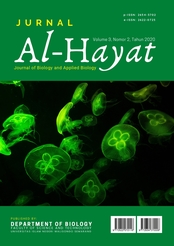Hubungan Kekerabatan Fenetik Pisang di Kecamatan Kabawetan, Kabupaten Kepahiang, Provinsi Bengkulu
Main Article Content
Abstract
Study of the genetic relationship between bananas carried out in Kabawetan Subdistrict, Kepahiang District, Bengkulu Province, from April to October 2019. Data collection on banana exploration studies is carried out in several locations of houses and community gardens in the form of wild plants and cultivation. Morphological data were compiled based on observations of morphological characters of specimens in the field, the character status was adapted from banana descriptors (IPGRI 1996). Morphological characterization results were observed and continued with character selection based on kinship in the form of a tree phenogram. Data were analyzed using the Numerical Taxonomy System (NTsys-pc) 2.02 program with the Unweight Pair Group Arithmetic Mean Method (UPGMA). The results found 6 types of banana diversity collection from 32 pseudo stands (individuals). The collection results obtained in the field are 1 collection of wild bananas and 5 cultivation collections. There are 6 banana distribution locations, namely Mekasari Village, Sumbersari Village, Babakan Village Bogor, Sumbersari Village, Tugu Rejo Village, Sido Rejo Village. Kinship of 6 types was found to have a similarity coefficient between 0.27 - 0.63. Phenograms divide into 2 large groups of 6 types of bananas, namely group A and group B, these two groups are separated by a similarity coefficient value of 0.27. Group A has a total of 5 types of bananas namely kapal, kapok , gembor, and jantan bananas.
Downloads
Article Details
The copyright of the received article shall be assigned to the journal as the publisher of the journal. The intended copyright includes the right to publish the article in various forms (including reprints). The journal maintains the publishing rights to the published articles. Authors are allowed to use their articles for any legal purposes deemed necessary without written permission from the journal with an acknowledgment of initial publication to this journal.
The work under license Creative Commons Attribution-ShareAlike 4.0 International License.
References
De Langhe, E. et al. (2009) ‘Why Bananas Matter: An Introduction to The History of Banana Domestication’, Ethnobotany Research and Applications, 7, pp. 165–178.
Hapsari, L. (2014) ‘Wild Musa Species Collection of Purwodadi Botanic Garden: Inventory and Its Morpho-taxonomic Review’, the Journal of Tropical Life Science, 4(1), pp. 70–80. doi: 10.11594/jtls.04.01.12.
International Plant Genetic Resources Institute (IPGRI) 1996, Descriptor for Banana (Musa spp.), Montpellier, IPGRIINIBAB/CIRAD.
Jumari & Pudjoarianto A. 2000. Kekerabatan Fenetik Kultivar Pisang Di Jawa.. J. Biologi 2(9):531-542.
Nasution, R. E. and Yamada, I. (2001) Pisang-Pisang Liar di Indonesia. Bogor: Puslitbang Biologi-LIPI.
Poerba, Y. S. et al. (2016) Katalog Pisang Koleksi Kebun Plasma Nutfah Pisang Pusat Penelitian Biologi. Jakarta: Lembaga Ilmu Pengetahuan Indonesia (LIPI).
Rohlf FJ. 1998. NTSYSpc, Numerical Taxonomy and Multivariate Analysis System Version 2.0. User Guide. New York, U.S: Applied Biostatic Inc.
Rugayah, Retnowati A, Windadri FI, Hidayat A. 2004. Pengumpulan Data Taksonomi. Di dalam: Rugayah, Widjaja EA, Praptiwi, editor. Pedoman Pengumpulan Data Keanekaragaman Flora. Bogor (ID): Pusat Penelitian Biologi-Lembaga Ilmu Pengetahuan Indonesia.
Sutanto A, D Sukma, C Hermanto and S Sudarsono. 2014. Isolation and characterization of resistance gene analogue (RGA) from Fusarium resistant banana cultivars. Emirates Journal of Food and Agriculture 26(6), 508-518.
Simmonds NW & Sheperd K. 1955. The taxonomy and origins of the cultivated bananas. J. Linn. Soc. Lond. Bot. 55: 302–312.
Sulistyaningsih, L. D. (2013) Pisang-Pisangan (Musaceae) di Gunung Watuwila dan Daerah Sekitarnya’, Floribunda, 4(5), pp. 121–125.

